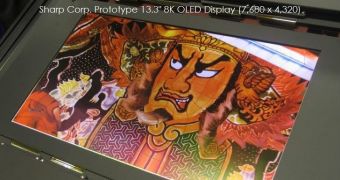Sharp is currently working in collaboration with a few other companies, in order to produce a notebook display capable of supporting a whopping 8K resolution.
Not so long ago, it was every PC user’s dream of having a full HD display on their personal desktop or notebook computer. Then smartphones and tablets came along and the desire was ported to the mobile ecosystem.
Apple introduced the concept of Retina display, a technology that brings about a pixel density that can’t be distinguished with the naked eye. And in a few years, we ended up seeing tablets with 2048 x 1536 pixel density and notebooks with 2K display.
Things are constantly evolving in the display department. For example, ASUS recently introduced the Zenbook NX500 laptop which arrives with a beautiful 3,840 x 2,160 pixel resolution.
If you think that’s pretty mind blowing, wait and see what Sharp and other Japanese companies are striving towards in terms of notebook display technology: a 13-inch OLED screen with a massive 8K resolution, reports Notebook Italia.
The 13.3-inch prototype was put on display at a conference of the Society of Information Displays (SID) and is being developed by well-known screen manufacturer Sharp in partnership with Semiconductor Energy Laboratory and Advanced Film Device.
The screen boasts massive a 7,680 x 4,320 pixels and 664ppi, according to documents made available by SID.
For those who are keen on knowing the technical details, the display is said to contain about 500 million pixel transistors, while the backplane has CAAC-OS (c-axis aligned crystalline oxide semiconductor) field effect transistors.
According to the producing companies, the display was realized by combining white-light OLEDs with three different microcavities, used to narrow wavelengths down to those of red (R), green (G) and blue (B) lights and adding color filters on top.
However, there’s a caveat to be mentioned here. It appears the red color rendering is pretty low, receiving 84% color gamut according to NTSC standards, while many OLED panels today score 100%.
As exciting as this might seem at a first glance, a spokesperson for Semiconductor Energy Laboratory mentioned it was difficult at this point to say whether the 8K panels would ever make it into consumer products.
8K panels are considered to be the successors of 4K and are displays containing about 8,000 pixels on the horizontal axis, with a total number of pixels being four times higher than those found in 4K and sixteen times that of full HD.
Japanese public broadcaster Nippon Hoso Kyokai (NHK) TV has been experimenting with 8K for some years and they have dubbed it Super Hi-Vision in the processor. But at least three years remain until final versions of such real-life products is assembled.

 14 DAY TRIAL //
14 DAY TRIAL //